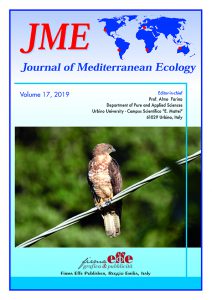Land degradation assessment using landscape unit approach and normalized difference vegetation index in Northwest of Tunisia
Donia Jendoubi, Elias Hodel, Hanspeter Liniger, Alemtsehay Teklay Subhatu
Centre for Development and Environment (CDE), University of Bern, Switzerland
Land managers and decision makers need sound, evidence-based information about land degradation patterns and about the effectiveness of their management practices. Obtaining such information is particularly difficult in Mediterranean lands, where for long time a combination of anthropogenic pressure, high topographical and climatic variability, and frequent disturbances created a complicated and unstable environment. Likewise, the normalized difference vegetation index (NDVI) has gained particular recognition in the scientific community as proxy of vegetation and degradation – given the importance of the vegetation cover in preventing land degradation in drylands. This study aims at designing a methodology to provide land managers in a representative site in Northwest of Tunisia with spatially explicit, up-to-date information on the state of their land, the pressures driving land degradation, and the effectiveness of their management efforts using remotely sensed NDVI data. To apply the NDVI index in the process of land degradation assessment, the variance of the annual average NDVI was analysed within different landscape units, which they were identified based on land cover, aspect, and slope steepness parameters. After calibrating and validating the land degradation mapping methodology using field observations, the obtained land degradation patterns were related with spatial information about overuse and monoculture, as well as fallow and agroforestry practices. Therefore, the main objective of this study is to create land degradation maps that show the state of semi-natural dry ecosystems and highlight man – made land degradation, then to assess the relation between patterns shown by the degradation map and the main pressure drivers affecting the study site. More specifically, three hypotheses derived from information provided by experts and stakeholders has to be proven: (1) Ecosystems are more sensitive to pressure in steep and south-facing terrain than in flat and north-facing areas. (2) Inappropriate management mainly the monoculture not led only to a physical soil deterioration but also the decline of soil fertility, particularly if they occur repeatedly in continuous way, especially in hilly south terrains, which are more exposed to solar radiation and erosion by wind and rain. (3) Third, we aimed to obtain evidence of the impact of specific land management practices that had been identified as promising.
Need for establishing National Observatories for the Environmental Impacts of Tourism
Sotirios Maipas
Master Program “Environment and Health. Management of Environmental Health Effects”, School of Medicine, National and Kapodistrian University of Athens, 75 Mikras Asias Str., 11527, Goudi, Athens, Greece
Many natural areas all over the world have been transformed into destination products with a great number of manmade facilities provided to accommodate large numbers of tourists, and to lengthen the tourist season. The tourism industry requires high energy input, and is responsible for a large part of greenhouse gas emissions. In addition, aquatic chemical and biological pollution, noise pollution, alteration of the appearance of natural ecosystems, deforestation, habitat loss, physical damages, and adverse effects on biodiversity are common negative outcomes of unsustainable tourism development. Moreover, the traditional relationship between locals and their natural surroundings undergoes constant change in favor of expanding income sources. As a result, unsustainable tourism development should be acknowledged as an “environmental health threat”. Although ecotourism does offer solutions, its marketing techniques should not be used as modern “Trojan Horses” for unsustainable economic development goals. The environmental degradation attributed to tourism industry requires monitoring, mitigating policy strategies and effective interdisciplinary and interprofessional collaboration between stakeholders. National Observatories for the Environmental Impacts of Tourism should be established – especially – in countries that depend extensively on tourism such as Greece, Italy and Spain. A functioning observatory would: monitor environmental quality in tourist areas, assess the environmental vulnerability of tourist natural attractions and accomplish environmental health and social impact assessments of tourist policies. The agency could also prepare scientific reports, agendas and summaries for policy makers, summaries for the general public and take an active stakeholder role in related decision-making processes. Moreover, it could organize environmental education programs and awareness-raising campaigns for both tourists and locals. It could further develop interdisciplinary and interprofessional collaborations, within and outside the tourism sector for the promotion of sustainable tourism, the expansion of relevant scientific research and for the promotion of renewable energy use in the tourism industry.
Impacts of Anthropogenic activities on the Habitats and Flora at the Coastal Nile Delta Mediterranean Region, Egypt
Elsayed M. Ali Nafea
Aquatic Environment Department, Faculty of Fish Resources, Suez University, Suez, Egypt
This work aimed to assess the impacts of anthropogenic activities on the habitats and their flora at the coastal Delta region of Egypt. One hundred and thirty species of plants were found in four habitats: saltmarshes, small sand dunes, high dunes and new reclaimed sandy lands. The recorded species related to 92 genera and 37 families, classified in 71 annuals, 58 perennials and one biennial. Therophytes were the most represented life form (76 species = 58.46%), while phanerophytes were the lowest one (8 species = 6.15%). The study area is subjected to many threats and suffers from environmental degradation and fragmentation and may lose its diversity if the anthropic impact will persist. Accordingly more species became rare (f.i., Pancratium maritimum L., Ammi visnaga L. and Asparagus stipularis L.), while two species were endangered and disappeared from the study area (Limoniastrum monopetalum L. and Ruppia maritima L.). The restoration of wetlands
seems dramatically urgent assuring a strategy of sustainable management.
